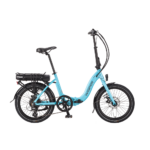Watts-Up vs Turnigy power meter / analyser
- Thread starter daniel.weck
- Start date
Hi Daniel.My Cycle Analyst (Stand-Alone model) is in the post. I should get it tonight.
I would be interested to know how you get on with the CA, I might get one in the near future.
I have recently bought and fitted one and it went well. It has allowed me to confirm my Ah use and estimate what new battery to get for when we move offices with a further commute.
So cycle analyst and new ping battery ordered in the last week!
I did have an issue with the speed sensor in that the top came off, but was replaced without drama by onbike (Phil old one is being sent back today)
Must remember to keep your eyes on the road though!
So cycle analyst and new ping battery ordered in the last week!
I did have an issue with the speed sensor in that the top came off, but was replaced without drama by onbike (Phil old one is being sent back today)
Must remember to keep your eyes on the road though!
Clicky:I got mine today. Nice piece of hardware, I can't wait to put it to use !
Daniel
http://www.pedelecs.co.uk/forum/electric-bicycles/4825-diy-stage-8-continuous-improvements-5.html#post63455
Hooray - my Raczing board finally arrived.
It sure is a small and neat little thing... Hardly there at all.

Took me a while to get the Java client working on my N96 - Turns out that there's a bug on the N96 which stops you installing Java apps if you have a card in the microSD slot - That was a fun one to debug.

Readings seem to match up pretty well with what the charger/discharger says too.. Volts are bang-on... Amps are a little bit out on one device.. but I couldn't guess which one.

I guess I'd better find a way of attaching this to my bike next. Fun Fun Fun.
It sure is a small and neat little thing... Hardly there at all.
Took me a while to get the Java client working on my N96 - Turns out that there's a bug on the N96 which stops you installing Java apps if you have a card in the microSD slot - That was a fun one to debug.
Readings seem to match up pretty well with what the charger/discharger says too.. Volts are bang-on... Amps are a little bit out on one device.. but I couldn't guess which one.
I guess I'd better find a way of attaching this to my bike next. Fun Fun Fun.
The GT Power watt meter / power analyzer has a nice rubber shell, backlit display, ... pretty much like the Turnigy and about the same price (25 GBP ballpark figure).
I love my Cycle Analyst though, it's worth the (much) more expensive bill. I like the built-in shunt sensor, which means I didn't need a high-amp cable loop between the handle bar and the rear-located battery/controller.



I love my Cycle Analyst though, it's worth the (much) more expensive bill. I like the built-in shunt sensor, which means I didn't need a high-amp cable loop between the handle bar and the rear-located battery/controller.



Oohhh ! (geek alert) 
I'd really like to correlate GPS tracking data (ascent gradients in particular) with live watt-meter information, and this electronic board could be the cheap and easy-to-use solution I've been looking for. It could even be used with the Cycle Analyst v2.11 and its new logging features, so the GPS distance/speed accuracies could be eliminated:
SparkFun Electronics - Logomatic v2 Serial SD Datalogger
SFE Logomatic V2 Serial microSD Datalogger - RobotShop

By the way, I found this info on Endless-Sphere...as you would expect
I'd really like to correlate GPS tracking data (ascent gradients in particular) with live watt-meter information, and this electronic board could be the cheap and easy-to-use solution I've been looking for. It could even be used with the Cycle Analyst v2.11 and its new logging features, so the GPS distance/speed accuracies could be eliminated:
SparkFun Electronics - Logomatic v2 Serial SD Datalogger
SFE Logomatic V2 Serial microSD Datalogger - RobotShop

By the way, I found this info on Endless-Sphere...as you would expect
Video review of the 2 devices mentioned in the original title of this thread ! 
YouTube - TURNIGY POWER ANALYZER WATTMETER REVIEW by Doctorbass
YouTube - TURNIGY POWER ANALYZER WATTMETER REVIEW by Doctorbass
Here's a nice low-power wifi module that transmits TTL data. It could be used to log the statistics emitted by the Cycle Analyst, or to update the controller firmware settings wireless-ly 
WiFly - 802.11b Ultra Low Power Module on Sale $58.75, 5 for $278.75, 10 for $536.00, 25 for $1,292.50, 50 for $2,493.00, 100 for $4,794.00 1-800-975-4743 USA

WiFly - 802.11b Ultra Low Power Module on Sale $58.75, 5 for $278.75, 10 for $536.00, 25 for $1,292.50, 50 for $2,493.00, 100 for $4,794.00 1-800-975-4743 USA
Interesting Dan seems much cheaper than the Watts Up too.
So does this Turnigy tell you how much Ah is left in the battery ?
Also as a comparrison (probably not a fair one as the Turnigy is much much cheaper) does the CA allow you to control Voltage as well as current, switching off at set threshholds ?
Assuming you already have a trip computer for you bike what else does the CA give you over and above the Turnigy ?
Regards
Jerry
So does this Turnigy tell you how much Ah is left in the battery ?
Also as a comparrison (probably not a fair one as the Turnigy is much much cheaper) does the CA allow you to control Voltage as well as current, switching off at set threshholds ?
Assuming you already have a trip computer for you bike what else does the CA give you over and above the Turnigy ?
Regards
Jerry
Apparently the Turnigy is slightly more weather-proof (hard screen overlay and no vents at the back), it has a back-lit display, and the rubbery body provides more grip. Other than that the specs are the same and they seem equally accurate (although the Watts-Up has been available for a while, so its reliability is proven).Interesting Dan seems much cheaper than the Watts Up too.
Note: I think that *only* the Cycle Analyst keep data in memory once the battery is disconnected, but you'd need to double-check that claim, as I'm not 100% sure.
I believe that they only tell you how many Amperes have been consumed over time (i.e. inverted fuel gauge in A/hour: current accumulated since the last time the device was reset, typically since the last full recharge cycle). The Cycle Analyst adds the notion of distance, but as far as I know it doesn't give you a prognostic as to much juice you have left. You have to deduct it from your battery capacity and rating.So does this Turnigy tell you how much Ah is left in the battery ?
For example in my case: 10Ah LifePo4 battery used at 1C discharge rate means that I can *climb a hill* for about one hour (because I know that approximately 10A are needed for the Bafang to develop approximately 370W of energy, which is what happens when I climb a hill whilst pedaling). Of course that's a peak value, and in practice you wouldn't want to totally exhaust your battery anyway. So in reality, you need to take into account an average consumption over a typical route, which as a matter of fact the CA indicates (say you've ridden 10 km and have consumed 2Ah, then you've got a pretty good idea of what to expect next). I'm not sure about the statistics provided by the other watt-meters.
The CA correlates these Ah or Wh values with distance units, so it makes it very easy to approximate how much assistance you've got left for a given remaining route. The Wh/km is particularly useful, as it shows the efficiency of your mode of transportation (i.e. human power + electrical assistance). Note: the W/h may seem "different" that the A/h due to the voltage drop/sag under high Amperes current draw.
I'm not sure. I think because they are generic watt-meters, they only display information, they don't offer features to influence the behavior of the system (i.e. control the power output).Also as a comparrison (probably not a fair one as the Turnigy is much much cheaper) does the CA allow you to control Voltage as well as current, switching off at set threshholds ?
The CA provides 3 types of limits: speed, volts, amps. For these features to be activated, the CA needs to act as a intermediary between the controller and the signal coming from the thumb throttle / PAS (i.e. you need to solder a few things). It's all explained in the PDF, although a concrete application will very much depend on the type of controller.
Dan
Related Articles
-
 MTF Enterprises announces acquisition of EMU Electric Bikes
MTF Enterprises announces acquisition of EMU Electric Bikes- Started by: Pedelecs
-
 Wisper 806T folding bike wins Which? ‘Best Buy’
Wisper 806T folding bike wins Which? ‘Best Buy’- Started by: Pedelecs
-
 Sustrans calls for protected cycle lanes
Sustrans calls for protected cycle lanes- Started by: Pedelecs
-
 Amazon launch their first UK e-cargo micromobility hub
Amazon launch their first UK e-cargo micromobility hub- Started by: Pedelecs



